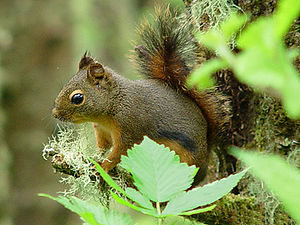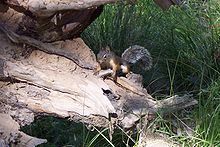Douglas croissants
| Douglas croissants | ||||||||||||
|---|---|---|---|---|---|---|---|---|---|---|---|---|

Douglas squirrel ( Tamiasciurus douglasii douglasii ) |
||||||||||||
| Systematics | ||||||||||||
|
||||||||||||
| Scientific name | ||||||||||||
| Tamiasciurus douglasii | ||||||||||||
| ( Bachman , 1839) |
The Douglas squirrel ( Tamiasciurus douglasii ) is a North American rodent belonging to the squirrel family (Sciuridae).
features
The fur of the Douglas squirrel is gray to brown-gray on the upper side, sometimes also slightly reddish; in the middle of the back it changes to maroon. The underside is yellowish white to orange in color; only in eastern Oregon is it white. The fur around the eyes is lighter. It has black stripes (lateral stripes) on the sides, which are mainly visible in summer. In winter these are not very pronounced or not present. The fur is often longer in winter and lighter on the belly; the ear brushes and dark circles are more pronounced. The top of the tail is colored similarly to the back, only the last third is darker. The underside of the tail is rust-colored in the center, the edge is black and lighter at the tips.
The Douglas squirrel looks very similar to the common red squirrel . However, this has a white to gray-white belly side and usually a lighter red on the back.
A fully grown animal can reach a body length of 270 to 348 millimeters. The tail is between 102 and 158, the hind legs between 41 and 55 millimeters long. The animals weigh between 141 and 312 grams. This makes the Douglas squirrel one of the smallest tree squirrels . It is assumed that the reason for the small body size is that the improved climbing possibilities compared to the food competition, in which larger animals have an advantage, have prevailed in the course of evolution . There is no dimorphism between the sexes.
Way of life
Douglas squirrels live mainly in Douglas fir forests or other forests where Douglas firs are present, as well as fir and spruce forests . They can be found at heights of up to 3,300 meters. There they inhabit nests, which in summer consist of twigs, moss , lichen and pieces of bark. Sometimes they also inhabit abandoned bird nests. In winter they live in abandoned nests of woodpeckers or below ground.
Douglas squirrels are diurnal and loners . They live in fixed territories from one to one and a half hectares . They are active all year round, but they retreat to their nests in bad weather and cold winters.
nutrition
Douglas squirrels spend a lot of time looking for food in the trees. They are well adapted to climbing thanks to their good jumping ability, strong claws and the tail that they use for balancing.
Douglas croissants are omnivores . They mainly feed on pine seeds . In addition, depending on the season, the animals eat mushrooms , the cambium of conifers , twigs, leaves, buds , acorns and nuts , fruits and berries . Sometimes they also consume arthropods , birds' eggs and nestlings of birds .
Reproduction
Males and females reach sexual maturity between eight and nine months of age. Mating occurs from January to mid-August, especially between March and May. Most females only have one litter per year. Sometimes a second litter follows in August or September. After a gestation period of between 36 and 40 days, the female gives birth to 1 to 8, on average 4 to 6, young animals; they weigh between 13 and 18 grams.
The young open their eyes after around 26 to 36 days and stay in their mother's nest until around mid-July to early August. However, they initially remain in contact with the mother even after they have left the nest. Weaning from the nest begins at six weeks and continues until the ninth week. After the boys have become independent, they will stay together in the family until December. After about nine to ten months, the young are fully grown.
distribution
Douglas squirrels are common along the Pacific coast of North America. However, the occurrence is limited to northern California to the Sierra Nevada and the Cascade Range with western and central Oregon , western Washington and southwestern British Columbia in Canada .
Systematics

The Douglas squirrel is classified as an independent species within the red squirrel ( Tamasciurus ). The first scientific description comes from John Bachman from 1839, who described it as Sciurus douglasii from the Columbia River area .
Within the species, together with the nominate form, three subspecies are distinguished:
- Tamiasciurus douglasii douglasii Bachman , 1839, in western Washington , Oregon, and California.
- the Mearns red squirrel ( Tamiasciurus douglasii mearnsi ) Townsend , 1897, in the northern part of the Baja California peninsula , Mexico.
- Tamiasciurus douglasii mollipilosus Audubon & Bachman, 1841, in central Washington and southwestern British Columbia .
The Mearns red squirrel is sometimes viewed as a separate species. Tamiasciurus douglasii albolimbatus Allen , 1890, in northern and central California and central Oregon is added as an additional subspecies in older literature , which is currently not considered to be independent.
supporting documents
- ↑ a b c J.L. Koprowski, EA Goldstein, KR Bennett, C. Pereira Mendes: Douglas's Squirrel. In: Don E. Wilson, TE Lacher, Jr., Russell A. Mittermeier (Eds.): Handbook of the Mammals of the World: Lagomorphs and Rodents 1. (HMW, Volume 6) Lynx Edicions, Barcelona 2016, p. 739 -740, ISBN 978-84-941892-3-4 .
- ↑ a b Richard W. Thorington Jr., John L. Koprowski, Michael A. Steele: Squirrels of the World. Johns Hopkins University Press, Baltimore MD 2012, ISBN 978-1-4214-0469-1 , pp. 78-80.
- ↑ a b c Tamiasciurus douglasii In: Don E. Wilson, DeeAnn M. Reeder (Ed.): Mammal Species of the World. A taxonomic and geographic Reference. 2 volumes. 3. Edition. Johns Hopkins University Press, Baltimore MD 2005, ISBN 0-8018-8221-4 .
literature
- JL Koprowski, EA Goldstein, KR Bennett, C. Pereira Mendes: Douglas's Squirrel. In: Don E. Wilson, TE Lacher, Jr., Russell A. Mittermeier (Eds.): Handbook of the Mammals of the World: Lagomorphs and Rodents 1. (HMW, Volume 6) Lynx Edicions, Barcelona 2016, p. 739 -740, ISBN 978-84-941892-3-4 .
- Richard W. Thorington Jr., John L. Koprowski, Michael A. Steele: Squirrels of the World. Johns Hopkins University Press, Baltimore MD 2012, ISBN 978-1-4214-0469-1 , pp. 78-80.
- Tamiasciurus douglasii - Mammalian Species (PDF file; 938 kB)
Web links
- Douglas' Squirrel at eNature.com
- Tamiasciurus douglasii inthe IUCN 2013 Red List of Threatened Species . Listed by: Linzey, AV & NatureServe (Hammerson, G.), 2008. Retrieved December 20, 2013.